Refrigerators: Recycled
Don't know what to do with that old refrigerator? Take a tour of a refrigerator recycling facility with Jeff Wilson, and find out how your old appliance can be decontaminated, deconstructed, and reused.
Now, refrigerator recycling may not be what you consider an essential “DIY” topic, but in light of a recent experience I had, I thought you might like to have this question answered: Where the heck do my appliances go when they get hauled away?

When I got the assignment to cover a refrigerator recycling plant in Stow, Ohio, I assumed it would be just another run-of-the-mill day. As a correspondent for Lifetime network’s Designing Spaces, I was supposed to give a tour of the plant as part of their “Think Green” segment in the series. Really? You want me to make refrigerator recycling interesting? I imagined assembly lines of low-wage workers slogging through mountains of discarded appliances in a junk-yard setting.
JACO Environmental was something entirely different. The high-tech facility was spotless, with orderly lines of old refrigerators and window-unit air conditioners lined up, ready for processing. Here, old appliances were unloaded at one end of the plant, while bags and palettes of reclaimed materials were hauled away at the other. Those parts and pieces – many of them no larger than my thumb – would be used as raw materials for new products.
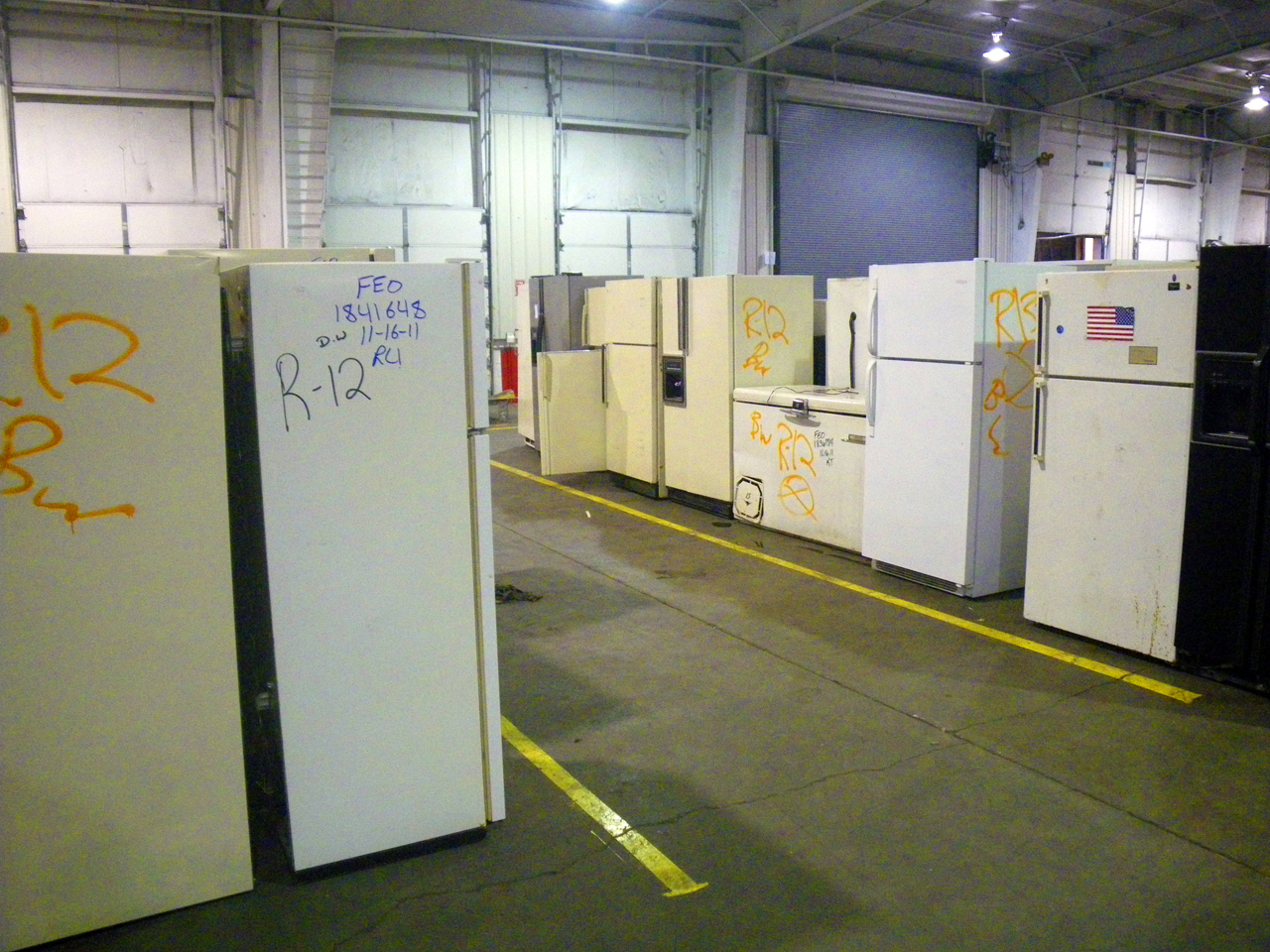
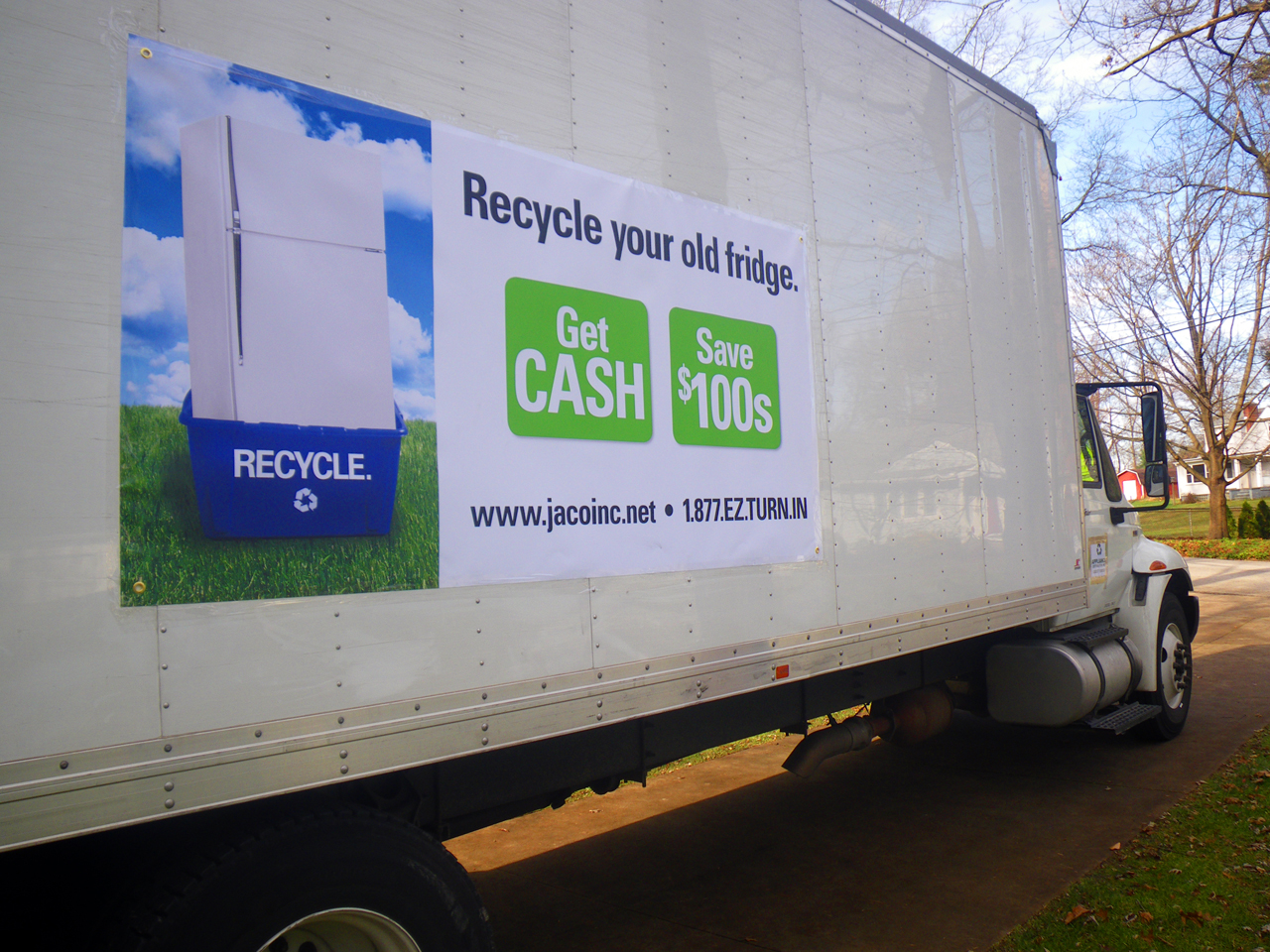
My tour guide was Michael Dunham, Director of Energy and Environmental Programs at JACO Environmental. We would be following a “vintage” avocado refrigerator which had been picked up that morning through the whole process.
First, the homeowner calls for a free pickup, where they answer a few quick questions and receive a $50 rebate voucher . . . yep, that’s right, they not only take it away, they pay for the privilege. Since JACO Environmental works with 150 different utility companies in 32 states, it’s likely that there’s a program near you. The power cord is clipped off, and the refrigerator is loaded on the truck, bound for the JACO plant.

Once there, several dozen guys, working with startling efficiency, remove the doors, shelves, bins, and other loose parts. The single-material pieces are easily sorted into separate recycling bins, while the multiple-material parts go through another process, which I’ll describe in a minute.
That done, they’re moved to a station where a technician removes the refrigerant – in this case a CFC called R-12. According to Michael Dunham, R-12 is a particularly nasty greenhouse gas with 10,000 times the heat-trapping power of CO2. The gas is removed with a sealed hose into a large tank. This tank will be shipped to an incinerator, where the R-12 will be destroyed so that it can’t leak out into the atmosphere. JACO is then able to sell the carbon credits associated with removing the gas from the environment. At the same time, the mineral oil which lubricates the compressor as the R-12 cycles through is cleaned of residual R-12 gas and collected for use as a clean-burning fuel.
Once the gas is removed from the refrigeration lines, the compressor is cut out. The compressor is full of copper and other valuable metals, but getting at them doesn’t make economic sense here in the States. So these are boxed up and sent to Pakistan, where low-wage workers disassemble the compressors to sort out the metals for recycling.

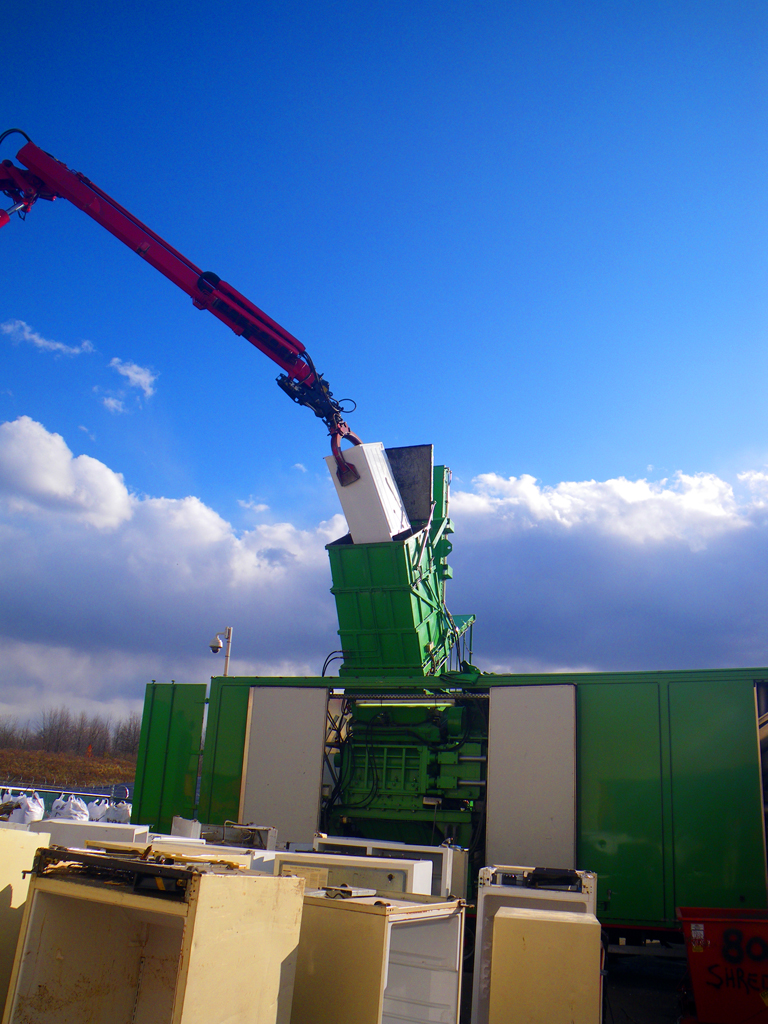
The now Freon-free refrigerator boxes are moved to the far end of the plant and outside the rear entrance. Here a leviathan machine, the length of two or three tractor trailers, whines and shakes. One by one, the boxes are snatched up by a crab-clawed crane, lifted into the air, and dropped into a chute. A door on the top of the chute closes and, with a hiss, a vacuum is pulled in the chamber.
The foreman yelled to me above the cacophony, “100 seconds!” I shook my head and shrugged. He pointed at the machine, “100 seconds from the time it’s dropped in until it comes out here!” The whining turned to an ungodly howl; the sound of an enormous blender in a tornado. I was still a little hazy about what was going on.
Just about the time I’d started processing things, the first of many metal “chips” started dropping out of a pipe into a dumpster. The foreman motioned me forward, “This is it – this is the ferrous metal from Amanda’s refrigerator!” The roar subsided a bit, as the last of the 2 inch square bits fell into the heap. “What happens to the rest of it?” I asked. He motioned me to the side to explain.
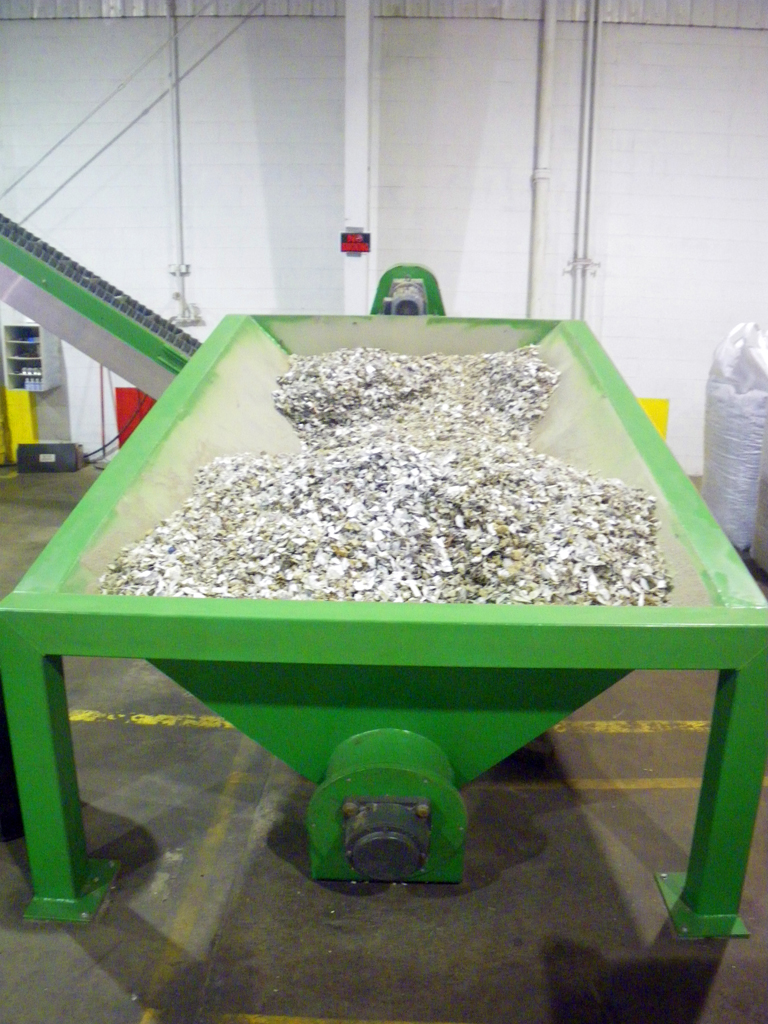
Once in the chamber, the refrigerator body is dropped into a “negative nitrogen” environment where it’s first shredded by a massive grinder. The ferrous metals are separated by magnets and dropped into the dumpster where I’d been standing. The non-ferrous metals (like copper and aluminum) are separated out, along with the plastic, into large bags. The big problem was the foam insulation.

Older foam insulation was expanded in its liquid form using another very potent greenhouse CFC, R-11. This foam looks like any of the expanding polyurethane foam you’d see today, only the bubbles inside this very efficient insulator contain R-11 gas. By pulverizing the foam, the gas is released into the negative nitrogen environment of the blender. JACO Environmental captures it, saving it in another container for incineration. By the way, the foam insulation in an old fridge holds more than a pound of R-11. That’s almost as much harmful CFC gas as what is used in the cooling system, so capturing that gas is critical. What’s left over of the foam after pulverization and capturing of the gas is a lightweight foam “dust” which is gathered in huge plastic bags and sent away to be recycled into products like carpet pad.
The non-ferrous metal & plastic chips, which are at this point mixed together, go through one more processing phase in a “vortex machine” that separates the metal from the plastic. Once the whole process is completed, 95% of each refrigerator is recycled, and the harmful greenhouse gases are removed and destroyed.

Who knew refrigerator recycling was so cool? Some pretty high technology has solved the problem of separating the myriad materials used old appliances, even the old injected foam insulation. What seemed an intractable problem has now been solved, thanks to enterprising folks like Michael Dunham and JACO Environmental. And I got to take home a couple of the shredded fridge pieces as souvenirs.
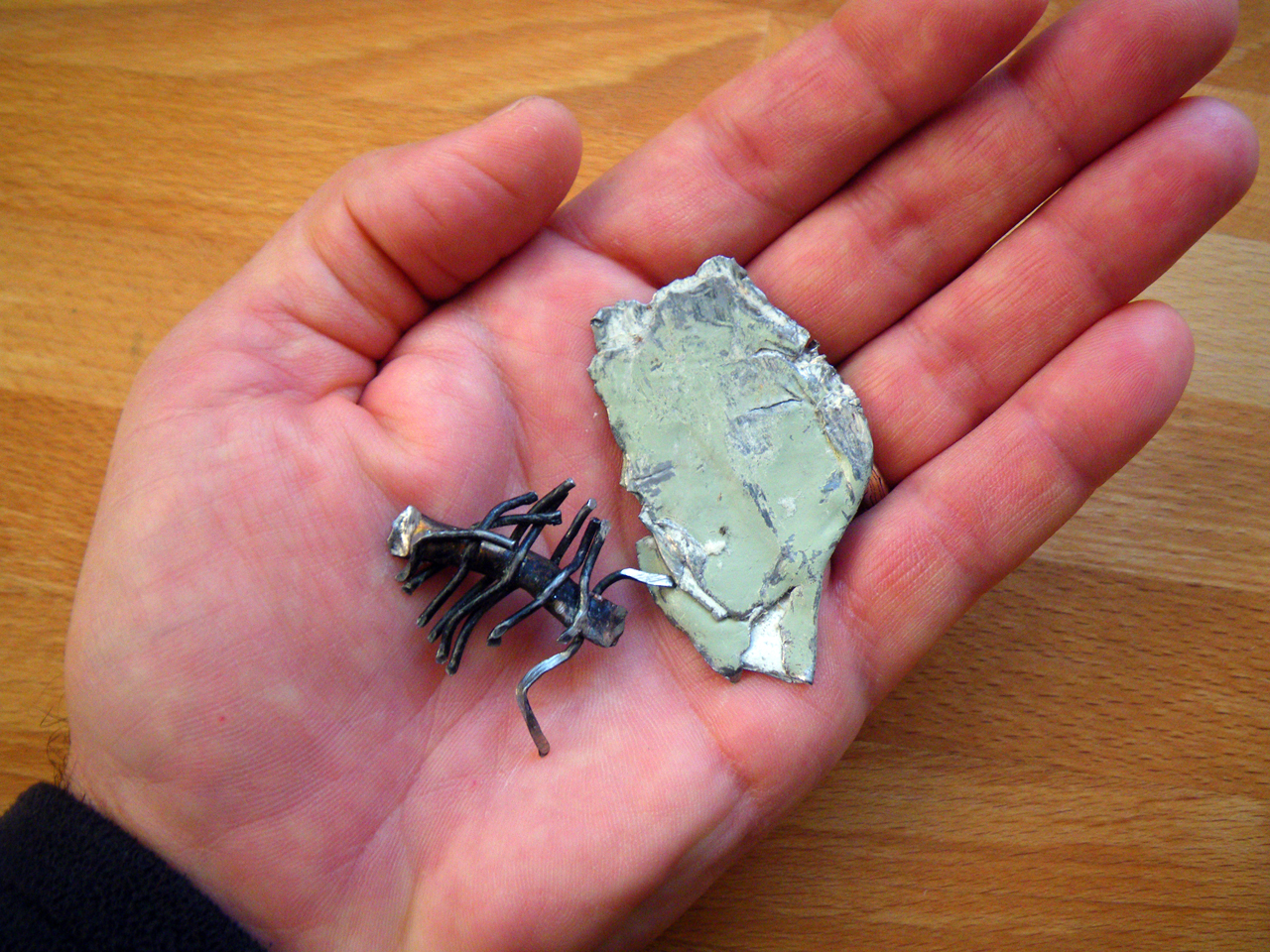
Do you need to recycle an old refrigerator, freezer, or room air conditioner? Go and enter your zip code to find out if you’re eligible. Also try asking your electrical utility if a similar program is available in your area. Don’t forget to check out the “Think Green” segment featuring this tour on an upcoming episode of Designing Spaces on Lifetime TV.

Jeff Wilson
Jeff Wilson, author of The Greened House Effect and host of Buildipedia's Everyday DIY series, many HGTV and diy network shows and 25-year veteran of the construction industry, lives with his wife and two daughters in a perpetually half-renovated home in a small college town in Ohio. You can see Jeff’s most recent project, the Deep Energy Retrofit of his 1940’s Cape Cod style home at thegreenedhouseeffect.com.
Website: www.jeffwilsonregularguy.com
